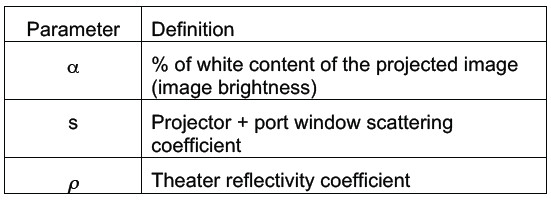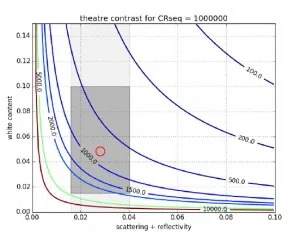Miller Schuck from RealD also gave a presentation on work they have done to understand the real contrast in a theater and how that might impact the design of a HDR projector. Schuck gave a similar talk at Display Summit in June (RealD Says 20,000:1 is Enough Contrast) where he concluded that have a high dynamic range projector with a native contrast ratio above 10,000: 1 or 20,000:1 offers diminishing returns – even in a darkened theatrical environment.
RealD analyzed the average luminance of a number of Blu-ray movies and found the average picture level was 8% of peak white. Using this factor, they found that the sample theater’s system contrast (sum of all components) was 600:1. This was influenced by the sequential contrast of the projector (1100:1), the room contrast (5000:1) and the veiling contrast from the projection lens (2000:1). This suggests that improvements in sequential contrast will have the biggest bang for the buck, followed by veiling contrast and room contrast.
Barco then presented a similar analysis of theater contrast, but used a different analytical approach to arrive at a similar conclusion. Goran Stojmenovik delivered the talk and used the formula below in his model.


Barco decided to measure the contrast ratio of the theater for different values of white content (using various checkerboard patterns) and the sequential contrast of the projector. The data could then be curve fitted to estimate the sum of scattering and theater reflectivity coefficients. Occlusion measurements are then needed to link the scattering coefficient to the theater reflectivity coefficient.
The measurements can be done quite quickly using a camera, several test patterns and an occlusion disk. Two exposures of each pattern are done (long exposure for the black level and short exposure of the white level). Results showed an excellent fit for the model.
With the model validated, Barco looked at projectors with a sequential contrast of 2000:1, representing today’s solution, and a projector with a sequential contrast of 1,000,000:1. The latter case is plotted below. The gray box in the middle represents the area of interest. The x axis corresponds to the range of scattering and reflectivity while the Y axis represents average luminance levels of the content. For the 5% light level and a 0.03 scattering & reflectivity value, the theater contrast is only 714:1 even with a very high contrast projector. Reducing the sequential contrast to a typical value of 2000:1 yields a contrast of 526:1 at the same conditions.

Comparing this result to the RealD result at 8% light levels shows that Barco model produces a contrast of around 400:1 while RealD obtained around 600:1 using their model.
For dark scenes at the 1.5% average light level, the 2000:1 projector yields a theater contrast of 1150:1 while the 1M:1 contrast projector yield a theater contrast of 2400:1. That is definitely better, but at what cost, asks Barco?
Barco drew three conclusions from this analysis:
- Auditorium reflectivity and scattering largely influence the effective theatre contrast for all image content, especially for median image brightness for which the projector choice makes little difference (700:1 for 1M:1 projector vs. 500:1 for a standard DLP projector).
- For average auditoriums and pretty dark image content (1.5%, defining a 10:90 split of the frame count), a 1M:1 projector only offers a twofold improvement in image contrast. Most of the contrast improvements happen with relatively lower projector contrast improvements due to the hyperbolic nature of the curve.
- For the very best auditoriums and even darker image content, the difference in contrast becomes more apparent – however this is for a fast decreasing number of movie frames as one moves further down from 1.5% frame brightness.

